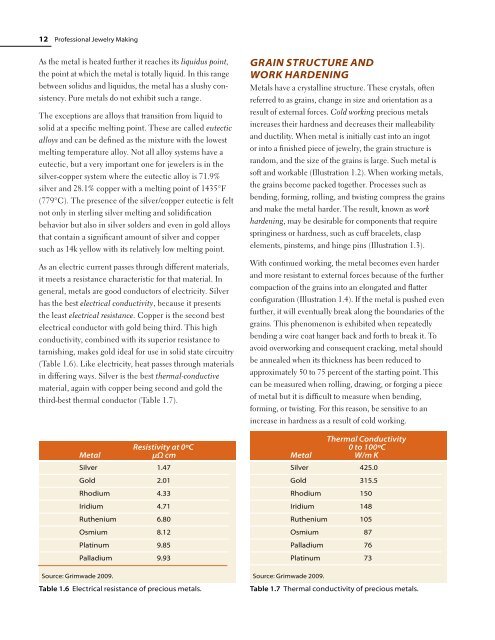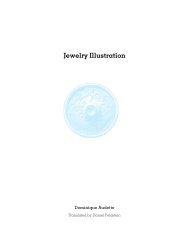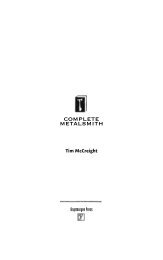Professional Jewelry Making - Brynmorgen Press
Professional Jewelry Making - Brynmorgen Press
Professional Jewelry Making - Brynmorgen Press
You also want an ePaper? Increase the reach of your titles
YUMPU automatically turns print PDFs into web optimized ePapers that Google loves.
12 <strong>Professional</strong> <strong>Jewelry</strong> <strong>Making</strong><br />
As the metal is heated further it reaches its liquidus point,<br />
the point at which the metal is totally liquid. In this range<br />
between solidus and liquidus, the metal has a slushy consistency.<br />
Pure metals do not exhibit such a range.<br />
The exceptions are alloys that transition from liquid to<br />
solid at a specific melting point. These are called eutectic<br />
alloys and can be defined as the mixture with the lowest<br />
melting temperature alloy. Not all alloy systems have a<br />
eutectic, but a very important one for jewelers is in the<br />
silver-copper system where the eutectic alloy is 71.9%<br />
silver and 28.1% copper with a melting point of 1435°F<br />
(779°C). The presence of the silver/copper eutectic is felt<br />
not only in sterling silver melting and solidification<br />
behavior but also in silver solders and even in gold alloys<br />
that contain a significant amount of silver and copper<br />
such as 14k yellow with its relatively low melting point.<br />
As an electric current passes through different materials,<br />
it meets a resistance characteristic for that material. In<br />
general, metals are good conductors of electricity. Silver<br />
has the best electrical conductivity, because it presents<br />
the least electrical resistance. Copper is the second best<br />
electrical conductor with gold being third. This high<br />
conductivity, combined with its superior resistance to<br />
tarnishing, makes gold ideal for use in solid state circuitry<br />
(Table 1.6). Like electricity, heat passes through materials<br />
in differing ways. Silver is the best thermal-conductive<br />
material, again with copper being second and gold the<br />
third-best thermal conductor (Table 1.7).<br />
Metal<br />
Resistivity at 0ºC<br />
µΩ cm<br />
Silver 1.47<br />
Gold 2.01<br />
rhodium 4.33<br />
Iridium 4.71<br />
ruthenium 6.80<br />
Osmium 8.12<br />
Platinum 9.85<br />
Palladium 9.93<br />
Source: Grimwade 2009.<br />
Table 1.6 electrical resistance of precious metals.<br />
grAIn strUctUre And<br />
work HArdenIng<br />
Metals have a crystalline structure. These crystals, often<br />
referred to as grains, change in size and orientation as a<br />
result of external forces. Cold working precious metals<br />
increases their hardness and decreases their malleability<br />
and ductility. When metal is initially cast into an ingot<br />
or into a finished piece of jewelry, the grain structure is<br />
random, and the size of the grains is large. Such metal is<br />
soft and workable (Illustration 1.2). When working metals,<br />
the grains become packed together. Processes such as<br />
bending, forming, rolling, and twisting compress the grains<br />
and make the metal harder. The result, known as work<br />
hardening, may be desirable for components that require<br />
springiness or hardness, such as cuff bracelets, clasp<br />
elements, pinstems, and hinge pins (Illustration 1.3).<br />
With continued working, the metal becomes even harder<br />
and more resistant to external forces because of the further<br />
compaction of the grains into an elongated and flatter<br />
configuration (Illustration 1.4). If the metal is pushed even<br />
further, it will eventually break along the boundaries of the<br />
grains. This phenomenon is exhibited when repeatedly<br />
bending a wire coat hanger back and forth to break it. To<br />
avoid overworking and consequent cracking, metal should<br />
be annealed when its thickness has been reduced to<br />
approximately 50 to 75 percent of the starting point. This<br />
can be measured when rolling, drawing, or forging a piece<br />
of metal but it is difficult to measure when bending,<br />
forming, or twisting. For this reason, be sensitive to an<br />
increase in hardness as a result of cold working.<br />
Metal<br />
Thermal Conductivity<br />
0 to 100ºC<br />
W/m K<br />
Silver 425.0<br />
Gold 315.5<br />
rhodium 150<br />
Iridium 148<br />
ruthenium 105<br />
Osmium 87<br />
Palladium 76<br />
Platinum 73<br />
Source: Grimwade 2009.<br />
Table 1.7 Thermal conductivity of precious metals.




